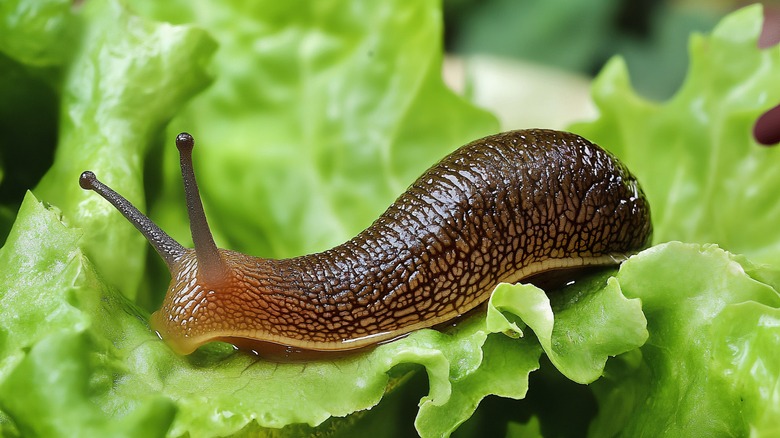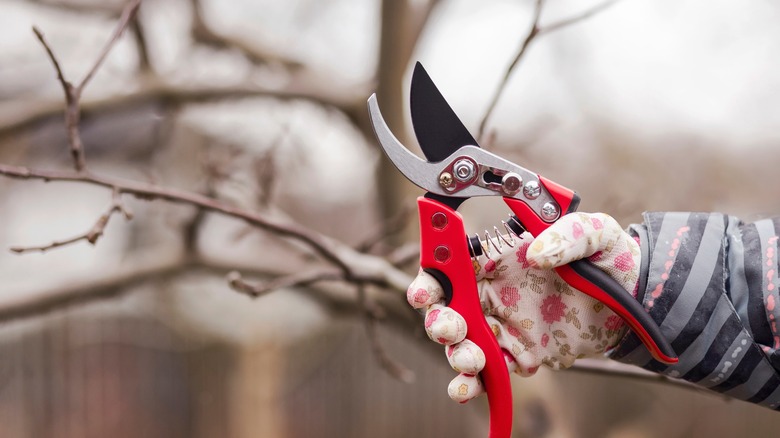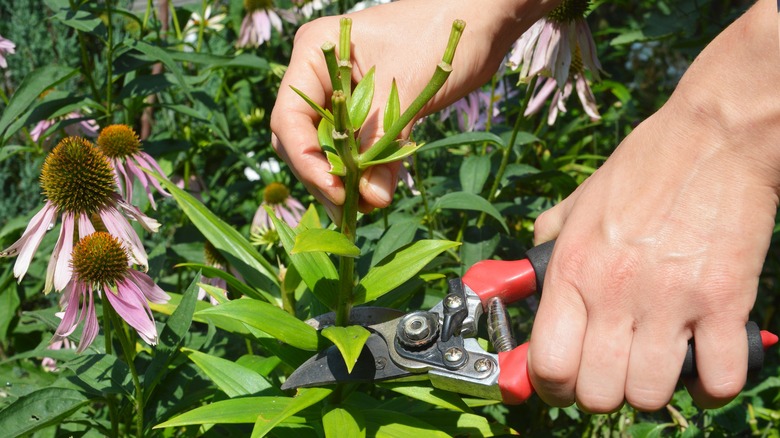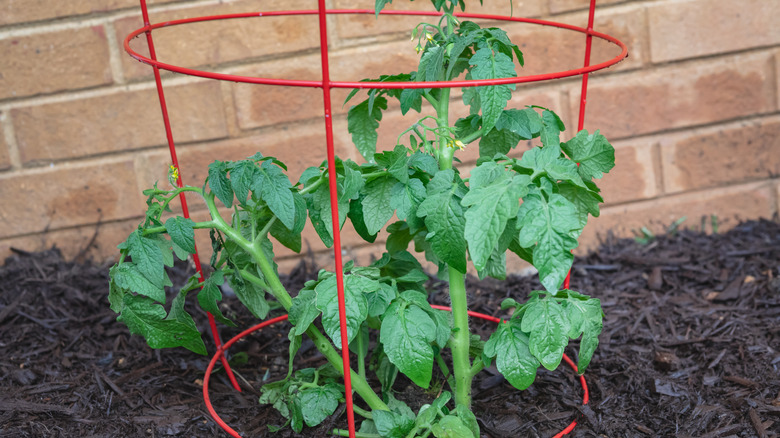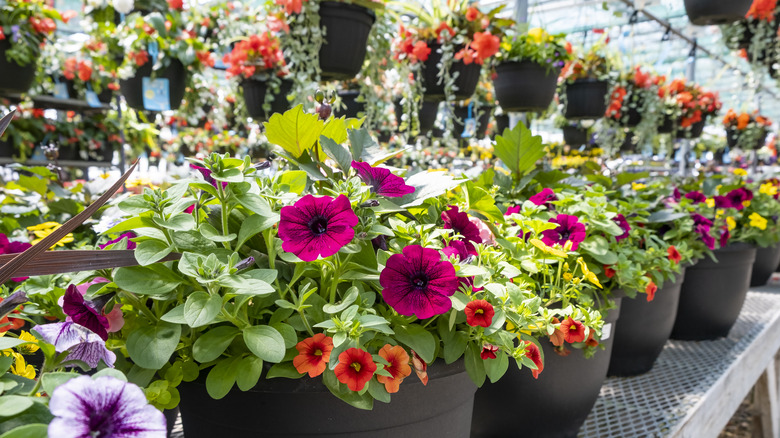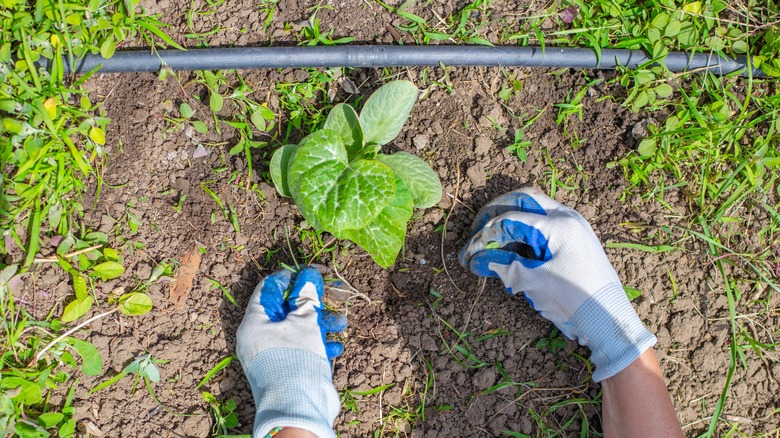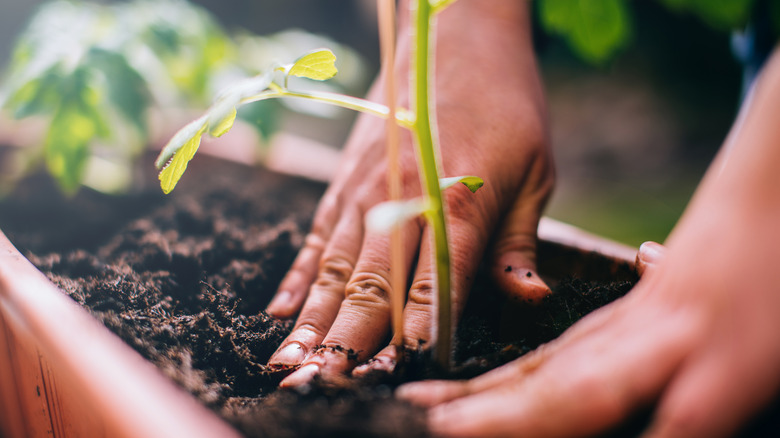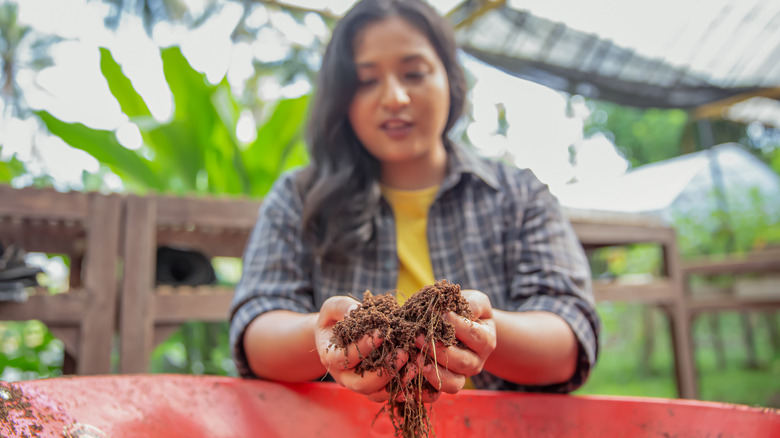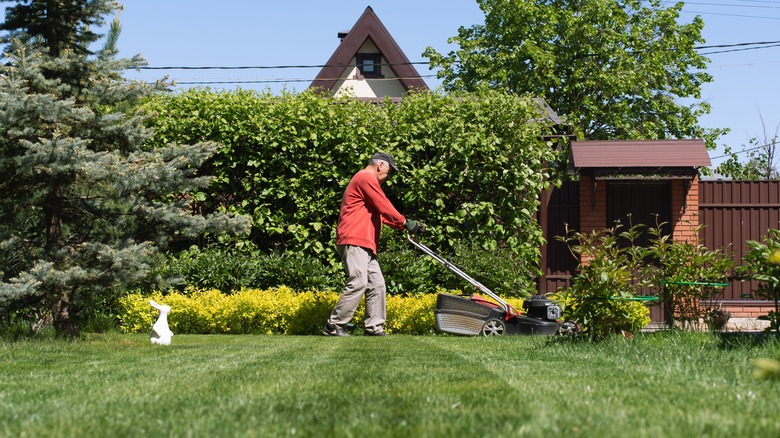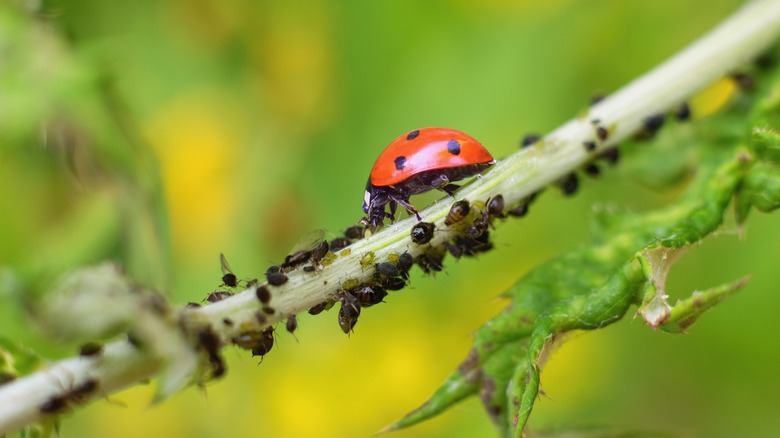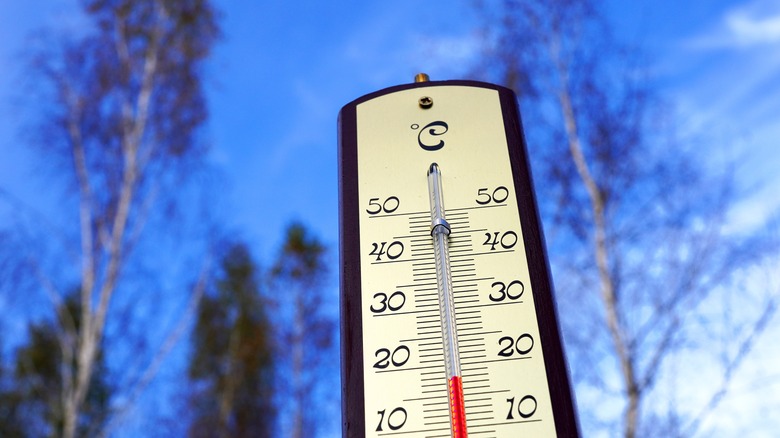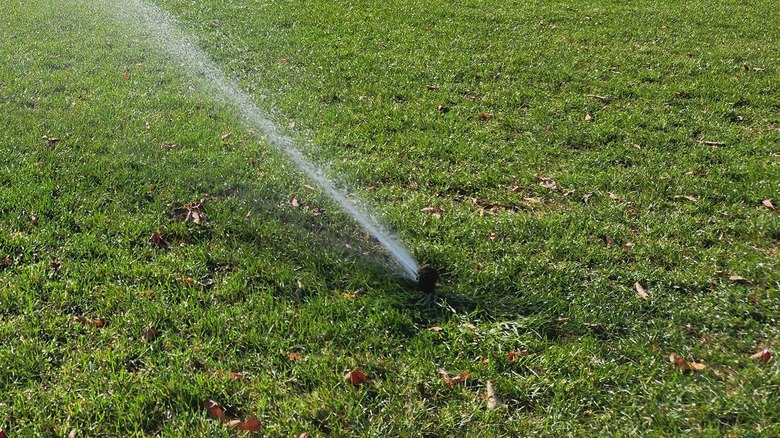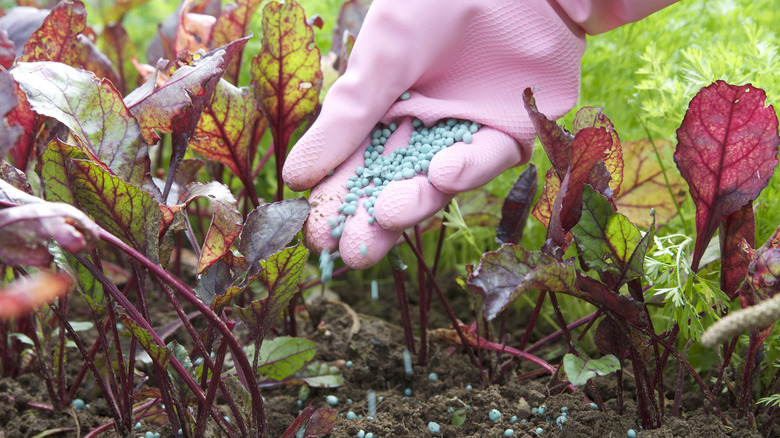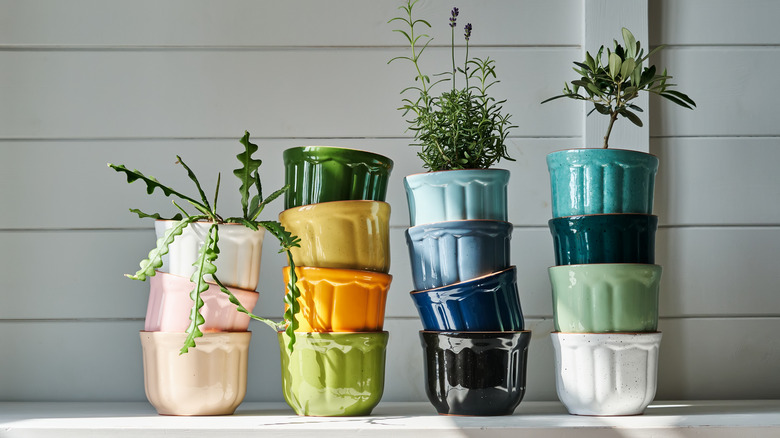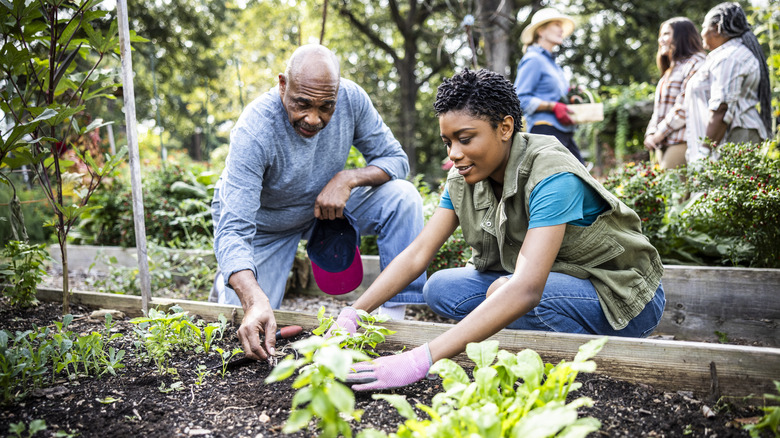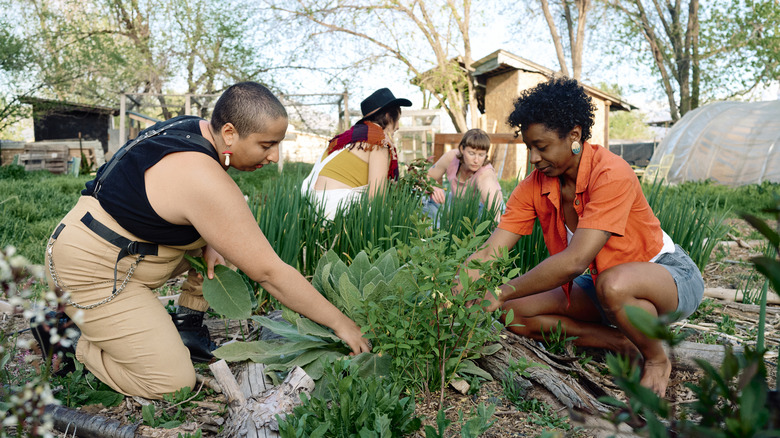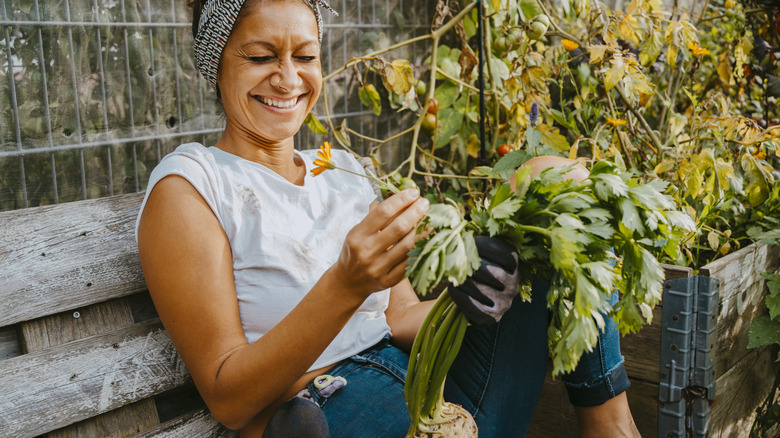How To Prepare Your Garden When You're Going On Vacation
We may receive a commission on purchases made from links.
There are many reasons to garden. Maybe you love harvesting fresh veggies from your yard. Perhaps you're an avid drinker of fruit and herb water infusions, and you're tired of paying store prices for the goods. Maybe you just like looking out the window and seeing hummingbirds or native bees popping by to visit your flowers. Whatever the case, it's important you keep your garden healthy year-round, and among the best gardening tips for beginners is knowing how to prepare before going on vacation.
"Vacations are a time to relax, and hopefully not stress about your plants back home," says Lindsay Springer, director of Plants, Nutrition, and Digital Agriculture at Gardyn. "While I have both outdoor and indoor gardens, the outdoor ones tend to keep me up at night while I'm away. I can't control the rain schedule, and I'm banking on other people to provide the basics so they survive, at the very least." It's a mistake, therefore, not to budget enough time to prep your garden before leaving, she says.
Rainy weather is only one of the possible consequences, says Karina Reginato, owner of Scottsdale Conserva Irrigation. "Heat damage from 100-plus-degree days can dehydrate plants in a matter of hours," she says. Irrigation leaks may go unnoticed and waste hundreds of gallons of water. Wilted or sunburned container plants can die quickly without proper shading or deep watering. Ripe fruit or unattended plants can attract pests like rodents or insects." If you don't want to return to sky-high water bills, dead plants, and a yard in disrepair, it's time to plan. Here are the most important steps to take before you go away.
Understand the risks
Knowing how to prepare your garden for vacation stems from knowing what might go wrong. "Routine watering, trimming, and pest management, if suddenly stopped, will create stress in the fragile ecosystem of your garden and push it to fight for survival," says Andy Wu, outdoor living expert and founder of Backyard Oasis. "On top of that, an untended garden will become an attractive target for opportunistic pests, diseases, and aggressive weeds that will invade and take over within a few days."
Melvin Cubian, plant care expert at PlantIn, agrees that the downsides of ill preparation shouldn't be overlooked. Plants can wilt due both to too little and too much water. Pest outbreaks and fungal diseases can come from plants that grow too tightly together and haven't been pruned recently. If you have an indoor garden, the same can occur in poorly ventilated rooms. Ultimately, plant death is your main concern, especially if you're going away for an extended period.
Consult seasonal pruning schedules
First up, you should prune carefully. "As plants mature, their older leaves may discolor and die back as the plant spends its precious energy on new growth," Lindsay Springer explains. "Get any dead plant matter out of the garden to encourage healthy airflow and prevent the molds that come with decaying plant matter." If you have tomatoes, shape them to ensure that none of the branches are rubbing together. The same goes for other edible and non-edible species. Especially if you care about coming back to a harvest, it's critical you learn how to prune properly.
If you're not sure what to prune or when, you might want to check out a book like "Pruning and Training, Revised New Edition: What, When, and How to Prune." It contains clear instructions on a wide variety of plants (over 800!) and can give you a good starting point, especially if you're old-school and want a handy physical guide you can lug out into the garden and squint at. (Raises hand.) Of course, Google also offers a great deal of free information on literally any plant under the sun, so choose the path that suits you best.
Deadhead spent flower heads
The next step in how to prepare your garden for vacation: deadheading flower heads. This is related to pruning but is a more specific kind. "Delicately deadheading faded flowers for a trip can make a big difference, diverting plants from expending energy on seed production and encouraging them to continue blooming in force in your absence," Andy Wu says. However, you shouldn't blanket deadhead. Rather, it's a species-by-species choice. "Some native plants (crucial for beneficial insects) depend on those seeds to be left uncut in order to survive," Wu explains, "making selectively deadheading the wiser, eco-friendly choice."
The partial deadheading technique can help here, he says. Snip off the petals to tidy up the plant, but leave the seed heads so they can continue to develop. Also, be aware that deadheading can stress some drought-tolerant plants, such as echinacea or black-eyed Susan: "Deadheading them can undercut their drought resistance, as the energy shifted to new blooms cranks up water needs while you're away." In that case, you might want to steer clear.
Either way, you need the right tools. For plants that have thicker stems or grow on twigs, a pair of clippers such as Gonicc 8" Professional Premium Titanium Bypass Pruning Shears will work. For more delicate work, Fiskars 6" Pruning Scissors are better.
Stake delicate plants
You can buy fruit and veggie plants online or at the store, but either way, they need the same type of care afterward. One of the most important things to do with veggies such as tomatoes or fruits like raspberries is to make sure they have the proper support while developing produce. If, for instance, you plant basil and tomato together, you should put tomatoes in cages to ensure fruit-laden boughs don't crush your basil.
"Top-heavy plants with long and slender stems like tomatoes, potted palms, or papaya are prone to falling over in wind or rain," Melvin Cubian says. "Secure them with stakes, cages, or soft ties to prevent damage. This not only protects the plants but also prevents stress on the roots and stems that could affect their growth." Tomatoes especially tend to have incredible growth spurts when your back is turned, Lindsay Springer says. "It's hard to case a tomato plant when it's already a monster bush. The sooner the better, from my experience." Consider a product such as Growneer 3 Pack of Tomato Cages.
Get new plants in the ground several weeks ahead of time
Don't wait to get new plants in the ground. Putting them in right before you leave is a recipe for disaster, as this is when plants need the most TLC. Even hardy plants need extra watering and inspection in the first few weeks after planting, because the stress of moving puts them at extra risk in the face of drought, extreme weather, or predation.
Another way to ensure your plants will survive when you're gone on vacation is to choose varieties you know work well in your area. For instance, says Karina Reginato, "We are based in Arizona, which is known for its desert climate." The best plants are highly drought-tolerant, whereas Washington State gardeners might want to opt for plants that tolerate wet feet. "Using native plants can yield more success since they are adapted to those particular climates," she adds.
Weed your plants
Weeding is also critical when preparing your garden for vacation. "If you let things go by the wayside for too long, the cascading effect of biology & the environment can pull things out of balance very quickly," Lindsay Springer says. "I like to get my beds weed-free before leaving to prevent advanced weed growth while I'm gone." Andy Wu agrees, pointing out that some weeds grow up to an inch a day in the right conditions, with root systems fully generating in just a few days. A clean slate can minimize the chances of this happening.
If you're frustrated by how to get up plants with tenacious roots, know that the NISAKU Original Hori Hori Namibagata Japanese Stainless Steel Weeding Knife has been an absolute game-changer in this writer's household. (We have two, and the four of us fight over them like wolves. Given the cost of around $22, you'd think we might just buy more hori horis, but here we are.)
Amend the soil
"This is a great time to amend your soil with compost or soil conditioner to improve moisture retention, especially in sandy or compacted soil yards," Karina Reginato says. While there are plenty of ways to do this over the long haul (looking at you, repurposing tea bags or leftover coffee grounds), it's best to take a straightforward approach before vacay.
You want to ensure your soil is light and drains well, yet will retain enough moisture so plants don't dry out. If you need more drainage, Coco Coir Bricks are perfect lighteners when torn up and mixed into the dirt. If you need retention, adding organic matter like compost and mulch does the trick. Each of these additions comes with its own rules and ratios, so look up how to do it rather than guessing.
Mulch garden beds
Mulching is key if you want to prepare your garden against cold, heat, moisture loss, and weeds, but you have to know how to do it. "A two- to three-inch layer of organic mulch like straw, bark, or shredded leaves keeps the soil cool and reduces evaporation," Melvin Cubian says. "This makes the plant roots more resilient during hot days," but it also keeps the soil warm if you get a frost.
Plus, even a layer that thin can reduce water evaporation by up to 70%, adds Andy Wu. "I recommend the 'sandwiching' technique, which consists of layers of thin and alternated bands of nitrogen-rich and carbon-rich materials," he says. Moreover, natural mulches are the way to go; avoid synthetic toppings. Karina Reginato agrees, advocating organic options such as bark or compost for flower beds, and granite or gravel for low-water landscapes, also known as xeriscapes.
Mow the lawn
Letting the lawn get tall encourages the development of seed heads in grasses, especially ones you don't want in your lawn (e.g., crab grass or goose grass). "Cutting your grass before your planned trip helps prevent overgrowth and avoid attracting pests," Melvin Cubian says. "Mow to a moderate height — don't scalp it too short, as that can expose roots to sunburn and dryness." If you'll be gone for more than a week, you might want to enlist someone to mow for you once.
If you don't want to use gas or electricity (and want to experience a little slice of this writer's childhood and teenage years), consider the Sun Joe MJ500M 16-Inch Manual Reel Mower With Adjustable Cutting Height. Manual lawnmowers are more effective than you might think, and they're a workout as well. Plus, you can learn how to use them in five minutes.
Inspect for pests and respond appropriately
"Leaving pest issues unchecked during vacation can cause serious plant decline by the time you return. Check for aphids, spider mites, whiteflies, or other insects common to your area that can multiply quickly in extreme heat," Karina Reginato says. Signs of activity include chewed leaves, webs, dark or scaley spots, cottony growths, or eggs, Melvin Cubian adds.
If you have a pest problem, Reginato recommends eco-friendly pest-fighting treatments to protect vulnerable plants while you're gone. Where possible, remove pests by hand to protect your plants as much as possible. Neem oil is a great way to naturally combat pests. Look up a recipe online that works in your area, then spray thoroughly and leave instructions for caretakers, if necessary.
Check the forecast
Another tip on how to prepare your garden for vacation is to, well, predict the weather. As much as you can, anyway. "Summer weather can be unpredictable, no matter where you live," Karina Reginato acknowledges. "It can be sunny one day and monsoon the next." Therefore, you should know what you're up against and plan for it before leaving. Know that a forecast of more than seven days out is only 40% accurate, Andy Wu adds, so it's good to plan for all eventualities.
Cold weather is also a concern, says Lindsay Springer, who lives in New York. "Frost and snow can wipe out my early planting or end the growing season for some plants," she says. "Ask a buddy (or neighbor) to cover your plants or take sensitive potted plants inside if you truly cherish them. Other random threats like high winds and hail might require some protective actions."
Set up a watering schedule or water deeply
Watering is perhaps the biggest challenge when considering how to prepare your garden for vacation. The unfortunate truth is that both over- and underwatering are areas of concern. To deal with this, deep watering is the way to go. Andy Wu says to shoot for wetting the top 8 to 12 inches of soil. Deep watering encourages plants to grow deep roots, which helps them access water lower down when topsoil dries out.
Make sure not only to water deeply before you leave but to give proper instructions: "To see to it that care is constant which is especially important during those unexpected heat waves consider putting in a timer for your irrigation system or get a caretaker to follow a very precise watering schedule." Watering early in the morning, between 4 and 7 a.m., is the best way to ensure that most of that water actually gets into the soil, Karina Reginato says, because it won't have a chance to evaporate in the heat.
Feed everyone
Plant feeding is high on the list of how to prepare your garden for vacation. If you have lots of different types of plants, Miracle-Gro Water Soluble All Purpose Plant Food for Indoor or Outdoor Plants is a good way to go. It takes care of the basic needs of most species, so you can focus on vacation planning instead.
If you really want to avoid the stress and unpredictability of outdoor gardening, Lindsay Springer says, you can consider an indoor gardening system that uses AI to address plant needs such as feeding, watering, and plant care. Many of these systems have a "vacation mode," so you can do a little prep work, flip a switch, and leave for weeks without having to worry.
Care for potted plants
Potted plant care is another step in preparing your garden for vacation. Many people who are good at taking care of their potted plants aren't sure, though, how to set them up for success in their absence. This is especially true as potted plants come with a number of challenges.
"Container plants often lose water faster than soil-planted ones, so prioritize them when setting up your watering plan or have them moved to partial shade to reduce heat stress and faster water evaporation," Melvin Cubian says. You can also group them together to create a mini humidity zone, and mulch the top of the soil to lock in moisture," Karina Reginato says. She loves self-watering globes, such as these Plant Watering Globes, or drip extensions to keep them hydrated without constant vigilance.
Make sure succulents get lots of sun while you're gone. Place them somewhere they'll get afternoon heat, so they don't get leggy and weak, Andy Wu says. On a final note, don't simply stick succulents into bright sun if they're not accustomed to an outdoor area yet. Strong, sudden sunlight on indoor succulent plants will burn them, so build up their tolerance over the week before you leave.
Harvest ahead
Another step to prepare your garden is to harvest ahead. When folks forget to pick ripe produce, Andy Wu says, the plants slow down on production. This causes wasted food. "If you're out of town during the peak of harvest season, invite neighbors to come pick from your plants," he advises. This "will in turn reduce waste and see your plants continue to produce."
Set up a clear harvest schedule, Lindsay Springer advises. "If you have a small zucchini today, you'll have a baseball bat in two days, and a pile of mush when you return if you don't have someone coming over to harvest." The same is true of strawberries, tomatoes, and eggplants, she adds: You can either pick them now or toss them later.
Get help if you need it
If you're going to leave on vacation for only a few days to a week, then consider how to keep your plants watered and harvested. "I usually ask my neighbor to water my garden daily when the plants mature, and if it doesn't rain," Lindsay Springer says. "In return, she's a fan of the daily harvest, so it's a win-win situation across the board." Make sure that you leave detailed enough instructions so people know what to water and harvest, if pots need moving or care, and if there are deeper needs (e.g., pruning).
If you have a timed watering system, have someone keep an eye on it. "Ask a neighbor or hire a professional to do a quick walk-through of your property mid-vacation," Karina Reginato says. "Even with a smart system, human eyes can spot a broken emitter, leaning plant or pest problem."
Schedule a check-in for as soon as you return
Make sure you plan some time with your garden when you return from vacation. Tasks to put on your list include inspecting the irrigation system, checking plants for signs of pests or rot, and harvesting any overabundance of produce. If you have an irrigation system, Karina Reginato says, make sure to look for dead zones that could indicate a problem with the hoses in that area.
In general, though, proper prep work should bring you back to a thriving garden. You will likely see more weeds than usual and may have to deal with a few critters, but that's okay. Ditto if some of the garden bullies have taken over, as they do without oversight. Plan to put in the work, and your yard will be right as rain in no time.

